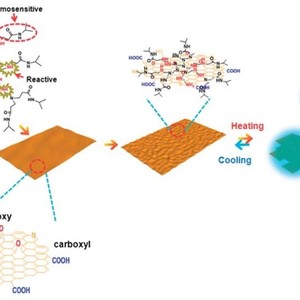Thermosensitive Hyperbranched Polyethylenimine Partially Substituted with N-isopropylacrylamide Monomer...
Abstract
A thermosensitive hyperbranched polyethylenimine (HPEI) partially substituted with N-isopropylacrylamide (NIPAM) monomer (HPEI-pNIPAM) was obtained and its thermodynamic properties were compared with the previously reported fully substituted hyperbranched HPEI-NIPAM polymer using calorimetric and turbidity measurements and one- and two-dimensional correlation infrared spectroscopy. With fewer NIPAM units embedded in the interior of the HPEI backbone, more hydrogen bonds between C![[double bond, length as m-dash]](http://www.rsc.org/images/entities/char_e001.gif) O and D2O in the HPEI-pNIPAM polymer could be transformed into C
O and D2O in the HPEI-pNIPAM polymer could be transformed into C![[double bond, length as m-dash]](http://www.rsc.org/images/entities/char_e001.gif) O/D–N bonds and fewer C
O/D–N bonds and fewer C![[double bond, length as m-dash]](http://www.rsc.org/images/entities/char_e001.gif) O related intermediates were formed during heating. During both the heating and cooling of HPEI-pNIPAM, collapse and restoration of the branched backbone occurred first, followed by the formation and debonding of self-associated C
O related intermediates were formed during heating. During both the heating and cooling of HPEI-pNIPAM, collapse and restoration of the branched backbone occurred first, followed by the formation and debonding of self-associated C![[double bond, length as m-dash]](http://www.rsc.org/images/entities/char_e001.gif) O/D–N hydrogen bonds in the same process; all of these processes might be due to a lower conformational confinement effect in the interior backbone leading to the formation of weaker hydrophobic–hydrophobic interactions. The residual NH groups in the hyperbranched thermosensitive HPEI-pNIPAM polymer could be used to bind to graphene oxide by the reaction of NH with epoxyl and carboxyl groups; it could also serve as a blocking reagent to prevent the aggregation of graphene during the preparation process. The new thermosensitive graphene composite obtained has a good potential for use in various biomedical or biosensor applications and provides opportunities for other similar hyperbranched polymers to be developed with responsive effects to multi-stimuli.
O/D–N hydrogen bonds in the same process; all of these processes might be due to a lower conformational confinement effect in the interior backbone leading to the formation of weaker hydrophobic–hydrophobic interactions. The residual NH groups in the hyperbranched thermosensitive HPEI-pNIPAM polymer could be used to bind to graphene oxide by the reaction of NH with epoxyl and carboxyl groups; it could also serve as a blocking reagent to prevent the aggregation of graphene during the preparation process. The new thermosensitive graphene composite obtained has a good potential for use in various biomedical or biosensor applications and provides opportunities for other similar hyperbranched polymers to be developed with responsive effects to multi-stimuli.

<<全文链接>>

